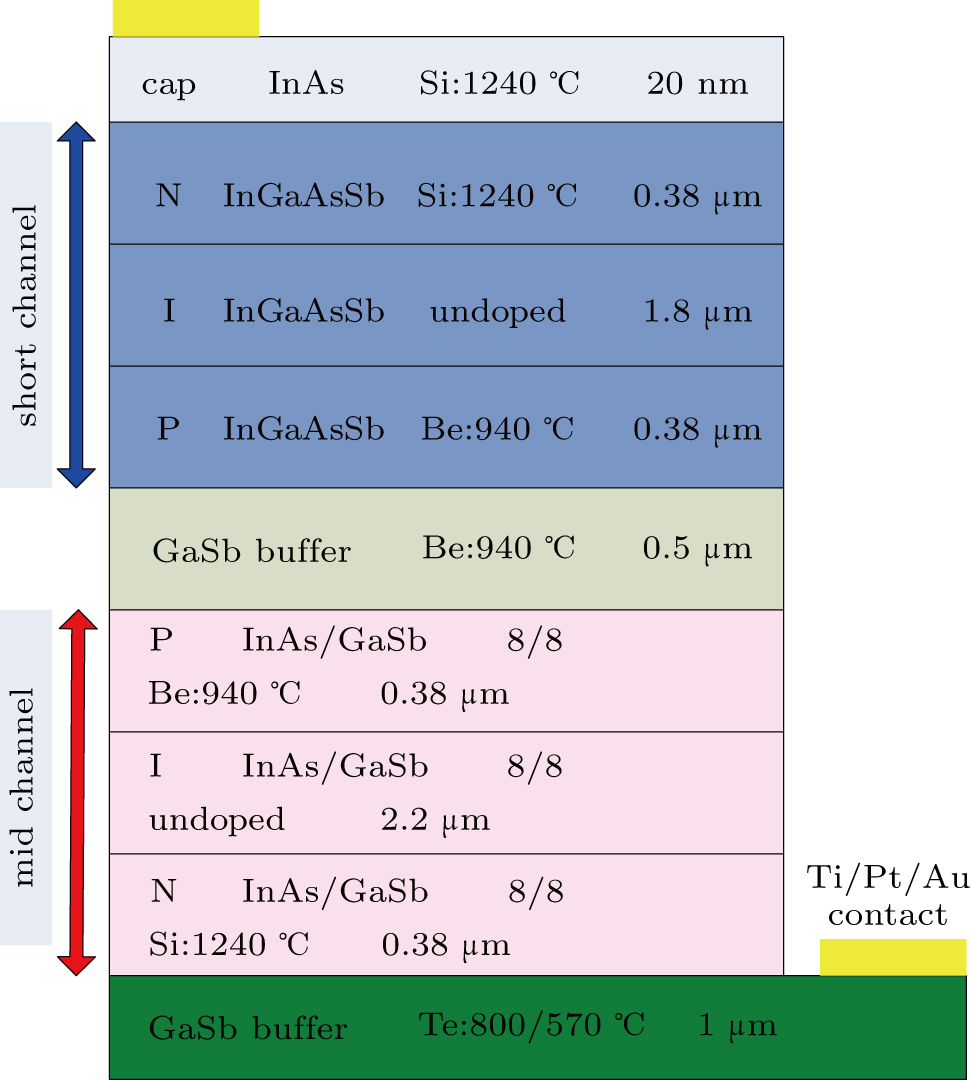† Corresponding author. E-mail:
Project supported by the National Basic Research Program of China (Grant Nos. 2016YFB0402403 and 2013CB932904), the National Natural Science Foundation of China (Grant Nos. 61290303 and 61306013), and China Postdoctoral Science Foundation (Grant No. 2016M601100).
In this paper, we demonstrate bias-selectable dual-band short- or mid-wavelength infrared photodetectors based on In0.24Ga0.76As0.21Sb0.79 bulk materials and InAs/GaSb type-II superlattices with cutoff wavelengths of 2.2 μm and 3.6 μm, respectively. At 200 K, the short-wave channel exhibits a peak quantum efficiency of 42% and a dark current density of 5.93 × 10−5 A/cm2 at 500 mV, thereby providing a detectivity of 1.55 × 1011 cm⋅Hz1/2/W. The mid-wave channel exhibits a peak quantum efficiency of 31% and a dark current density of 1.22 × 10−3 A/cm2 at −300 mV, thereby resulting in a detectivity of 2.71 × 1010 cm⋅Hz1/2/W. Moreover, we discuss the band alignment and spectral cross-talk of the dual-band n-i-p-p-i-n structure.
Short-wave infrared (SWIR) bands, from 1 μm to 3 μm, can offer high-resolution images comparable to visible perspective and exhibit the capacity to perform both passive and active imaging. Meanwhile, mid-wave infrared (MWIR) bands, corresponding to the atmospheric window between 3 μm to 5 μm, are widely utilized for military applications. Therefore, the combination of SWIR and MWIR is considerably essential and highly required in a number of tracking and reconnaissance missions. The dual-color SWIR–MWIR imagers permit more enhanced target identification and detection of chemical signatures specific to a waveband than single-color imagers.[1,2]
Bulk semiconductor materials, such as InGaAs for the SWIR and InSb for the MWIR, exhibit the advantages of high absorption coefficient and quantum efficiency. However, they are also limited to a particular detection window near the bandgap.[3] HgCdTe is a particular family that can tailor the cutoff wavelength from SWIR to considerably long-wave infrared (VLWIR) by changing the molar fraction of Cd. However, it exhibits high cost and toxicity.[4,5] Quantum well infrared photodetectors (QWIPs) and quantum dot infrared photodetectors (QDIPs) are alternatives to infrared detection. However, they were proved to present lower quantum efficiency and larger dark current, which limit the frame rate and operating temperature of focal plane arrays.[6] Another feasible scheme is type-II superlattices (SLs) introduced by Esaki and Tsu. The detection range can also cover from SWIR to VLWIR by changing the relative thickness of alternate layers. Reports on the subject were published intensively within the past two decades based on traditional InAs/GaSb SLs and modified Ga-free SLs.[7–10]
The quaternary alloy In0.24Ga0.76As0.21Sb0.79, lattice matched to GaSb substrate, is a promising candidate for the optoelectronic devices in the short-wave range. During the past few years, InGaAsSb detectors were reported with different structures grown on GaSb substrates.[11,12] In this study, we first combine the InGaAsSb bulk material and InAs/GaSb SLs to fabricate bias-selectable dual-color short- or mid-wavelength infrared detectors.
For this study, the material was grown in a solid source Gen II molecular beam epitaxy (MBE) reactor on an n-type GaSb (001) substrate with As2 and Sb2 valved cracker sources. As shown in Fig.
The high-resolution x-ray diffraction (HRXRD) pattern of the device is shown in Fig.
Fabrication was started with SiO2 deposition on wafers as a hard etching mask. SiO2 etching was performed for defining the mesas after standard UV photolithography. Then, inductively coupled plasma (ICP) dry etching was performed to the bottom GaSb buffer layer by using gases of CH4/Cl4/Ar2. After the residual SiO2 is eliminated using the ICP, the devices were passivated by using anodic sulfide as chemical passivation for filling dangling bonds on the surface.[13] Subsequently, a 200 nm SiO2 layer was deposited by ion-beam sputtering deposition (IBSD) as the physical passivation.[14,15] Then, a second photolithography was performed for opening the windows on the SiO2 as metal contact holes. The top and bottom metal electrodes were formed using electron beam deposited Ti (500 Å)/Pt (500 Å)/Au (3000 Å). Finally, the fabrication was completed using a standard lift-off process.
The device was wire bonded within a chip fixed in a Dewar, which was cooled to 77 K by using liquid nitrogen. The spectral response shown in Fig.
It is essential to mention that each individual n-i-p detector shows no response bias dependence when operated separately. The spectral response bias dependence of dual-color photodetectors could be explained by the band alignment and built-in voltage in the back-to-back junctions. Figure
The current–voltage characterization was measured and calculated at 200 K. Figure
 | Fig. 5. (color online) Dark current density and differential resistance-area product vs. applied bias of diode at 200 K. |
The optical characterization of the diodes was performed using a FTIR spectrometer and a calibrated blackbody source of 500 °C without any anti-reflection (AR) coating. Figure
 |




Then, the dark current short noise limited detectivity (D*) was calculated for both channels at 200 K. As shown in Fig.
In this paper, we demonstrate dual-band short- or mid-wavelength infrared photodetectors using InGaAsSb bulk material and InAs/GaSb superlattice. The 50% cutoff wavelengths are 2.2 μm and 3.6 μm for the SWIR channel and MWIR channel, respectively. At 200 K, the peak D* of the MWIR channel and SWIR channel are 2.64 × 1010 cm⋅Hz1/2/W and 1.54 × 1011 cm⋅Hz1/2/W, respectively.
| [1] | |
| [2] | |
| [3] | |
| [4] | |
| [5] | |
| [6] | |
| [7] | |
| [8] | |
| [9] | |
| [10] | |
| [11] | |
| [12] | |
| [13] | |
| [14] | |
| [15] | |
| [16] |






